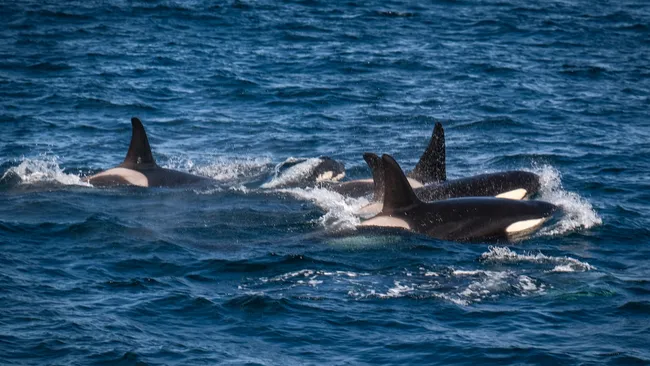A massive gang of over 60 orcas was seen brutalizing an endangered pygmy blue whale off the coast of Western Australia by a whalewatching tour.
A group of over 60 orcas launched a brutal attack on a 59-foot-long (18 meters) pygmy blue whale, killing it in a shocking display witnessed by a nearby whale-watching tour, as new video footage reveals.
The dramatic event took place in Bremer Canyon, a marine park located off the coast of Bremer Bay in Western Australia, on Monday, April 7. In the footage, posted by the tour company Naturaliste Charters on Instagram, the massive group of orcas (Orcinus orca) can be seen hunting in unison, circling the endangered pygmy blue whale (Balaenoptera musculus brevicauda). The whale is eventually seen floating lifeless on the ocean’s surface, blood pouring from its mouth as the orcas feast on their hard-won meal.
“We witnessed an incredible and rare event yesterday as multiple pods of orcas successfully hunted a blue whale in Bremer Canyon,” Naturaliste Charters shared on Facebook, accompanying the post with images of the extraordinary occurrence. “The intense ordeal lasted less than 40 minutes from when we first saw the blue at the surface to when the battle ended.” As the whale succumbed to its fate, the orcas celebrated with breaches and tail slaps.
This event is one of only a few times orcas have been seen attacking a blue whale species, according to Naturaliste Charters representatives. Orcas are known for their intelligence and ability to hunt in highly coordinated groups, using advanced communication and teamwork to bring down prey much larger than themselves. They are notorious for employing brutal tactics, such as creating waves to wash seals off floating ice, separating whale calves from their mothers, and even removing the livers of sharks.
“We’re all still pretty shell-shocked,” said marine biologist Jennah Tucker, who works for Naturaliste Charters and witnessed the event. “It was all over so quickly for such a massive animal.”
The pygmy blue whale was seen covered in bite marks, with as many as 30 orcas swarming it at once. “We estimated around 60 orcas involved, possibly more,” Tucker added. “We confirmed that five different family groups were involved. We typically see many orcas join once the whale is down, but this time we saw 20 to 30 at a time crowding the whale to take it down.”
Tucker also noted that several juvenile orcas participated in the feeding frenzy, including a calf as young as a month old. “They get involved from a very young age — this calf had no teeth but stayed close to mom’s side,” she explained.
Pygmy blue whales are a subspecies of the blue whale, the largest animal on Earth. While regular blue whales can grow up to 110 feet (34 meters), pygmy blue whales grow to about 79 feet (24 meters). Although smaller than their cousins, pygmy blue whales are still longer than many other whale species, including humpbacks and sperm whales. Orcas, in contrast, typically grow to no more than 32 feet (10 meters).
Pygmy blue whales are mainly found in the Indian Ocean and the southwestern Pacific Ocean, preferring warmer tropical and temperate waters. Though considered endangered by the International Union for Conservation of Nature (IUCN), the IUCN lists pygmy blue whales as Data Deficient, and under the Australian Environment Protection and Biodiversity Conservation Act, they are classified as endangered.
“It’s difficult to watch, especially when it’s an animal we know is struggling to recover from the history of whaling,” Tucker said, acknowledging the emotional aspect of witnessing such a violent event. “Pygmy blue whales are endangered. It was emotional, but that’s nature. It was a privilege to witness.”
